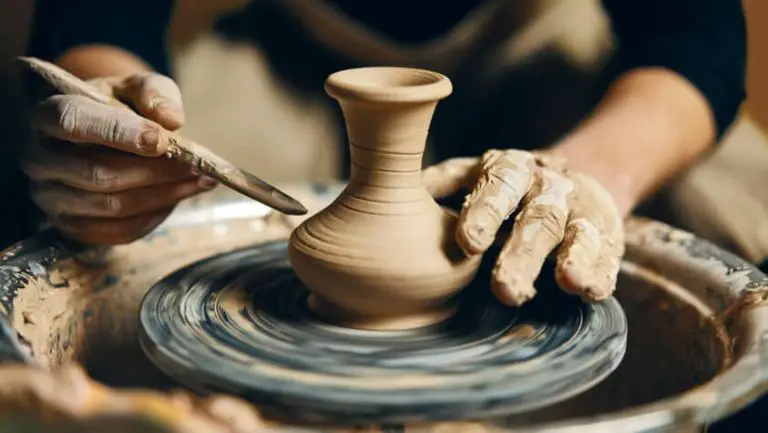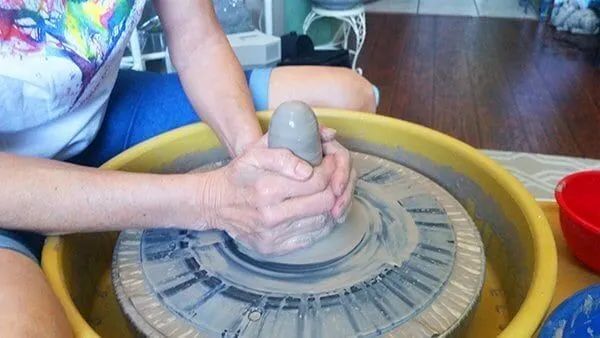What Do We Use Clay For?
Clay is a naturally occurring substance composed of very fine mineral particles. When mixed with water, clay becomes moldable and can be shaped into various objects before being hardened through firing or drying. With its malleable and adaptable properties, clay has served various practical purposes for humankind throughout history. Its availability across most parts of the world, along with its versatility and durability as a material, has made it an indispensable part of human civilization.
The key characteristics that make clay so useful are its plasticity when wet, its hardness when dried or fired, and its ability to withstand very high temperatures. Clay particles bond tightly together, creating a non-porous material once solidified. This allows clay to hold liquid, withstand heavy use and pressure, and retain heat. These unique physical attributes have enabled the molding of clay into items like pottery, bricks, irrigation pipes, art sculptures, building foundations, and roofing tiles.
Pottery
Pottery is one of the oldest uses of clay, with artifacts dating back over 20,000 years. Clay is an ideal material for making pottery because it is pliable when wet and hardens when fired at high temperatures. The oldest known pottery was discovered in China and dates back to 18,000-20,000 years ago. These early pots were hand formed from clay and fired in open fires or primitive kilns.
Different types of clay are used for pottery depending on the minerals and impurities present which impact its workability and firing temperature. Earthenware clays contain a high percentage of iron and other impurities and are porous when fired at lower temperatures. Stoneware clays are less porous and fire to a strong, vitrified state at higher temperatures. Porcelain clays can be fired at extremely high temperatures to produce a translucent, glass-like product.
Some key innovations in pottery include the pottery wheel which enabled symmetrical vessel shapes, glazing to make pottery impermeable to liquids, and kilns which allowed firing at precise temperatures. Although largely replaced by other materials like glass and metal today, pottery remains an important artistic medium around the world.
Construction Materials
Clay is a crucial material for building construction. The most common uses of clay in construction include:
Bricks – Clay bricks have been used in construction for thousands of years. Modern clay bricks are formed from clays mixed with additives and then fired in a kiln. Bricks made from clay are durable, fire-resistant, and effective insulation.
Tiles – Clay tiles are used for flooring, walls, and roofs in buildings. Ceramic tiles made from clay offer durability, aesthetic options, and water resistance. Terracotta tiles are a traditional roofing material made from clay.
Cement – Clay is a key ingredient in Portland cement, the binder used in concrete. Cement production involves heating a mix of clay and limestone to form clinker, which is then ground with other additives. The clay provides critical silicates for the chemical reaction.
In addition to bricks, tiles, and cement, clay is used for specialty construction materials like clay pipe and architectural terra cotta. The versatility and abundance of clay makes it invaluable for building infrastructure globally.
Paper
Clay is a crucial ingredient in modern paper production. It is used as both a filler and a coating. Clay fillers like kaolin and calcium carbonate are added to the pulp mixture during paper manufacturing. The clay particles fill the spaces between pulp fibers, resulting in a smoother and more opaque paper.
The main benefits of adding clay as a filler are:
- It improves the brightness and whiteness of the paper
- It improves printability by creating a flatter, smoother surface
- It makes the paper more opaque so less ink is required for printing
Clay coatings containing china clay, calcium carbonate, and talc are also applied to paper surfaces. These coatings improve smoothness, brightness, opacity, and ink holdout. The clay coating fills pores in the paper and creates a barrier so the ink does not sink into the paper. This leads to sharper printed images.
Medicine
Clay has been used medicinally for centuries in traditional healing practices around the world. The earliest recorded medical use of clay dates back to ancient Mesopotamia. Tablets from around 2500 BC describe medicinal clay poultices being applied to wounds. In traditional Chinese medicine, mineral clays were used internally to treat digestive issues and externally for skin conditions. Australian aboriginals used native clays, called kurrajong, to treat wounds, sprains, and skin infections.
The key to medicinal clay lies in its chemical absorbent properties. Clays contain a range of minerals including silica, iron, magnesium, calcium, sodium, and potassium. When mixed with water, these minerals carry a weak electrical charge that bonds with toxins, heavy metals, and other impurities. Medicinal clays essentially “pull” contaminants out of skin and the digestive tract when applied topically or ingested.
Modern medical research has confirmed some of the traditional medicinal uses of clay. Kaolin clay and bentonite clay are the two clays most extensively studied and used in modern medicine. Kaolin is the active ingredient in many over-the-counter diarrhea remedies like Kaopectate. It absorbs toxins and pathogens from the digestive tract. Bentonite clay has been proven in studies to be effective at removing heavy metals from the body and soothing skin conditions like poison ivy. More research is still needed, but medicinal clays show promise as a natural, safe and inexpensive treatment for certain medical conditions.
Cosmetics
Clay is a common ingredient used in many cosmetic and skincare products. The natural absorbent properties of clay make it useful for soaps, face masks, shampoos and more. Some specific ways clay is utilized in cosmetic formulations include:
– Clay soaps – Clays like kaolin and bentonite are added to soaps for their cleansing and exfoliating properties. The minerals in clay help draw out impurities from the skin.
– Face masks – Clays are a staple ingredient in facial masks. Kaolin clay and bentonite clay help remove dirt and oil from skin and improve overall complexion. Clay masks also help nourish skin.
– Shampoos – Clays give shampoos a thick, creamy texture. They help boost cleaning power to absorb oil and product buildup from hair. Clays also help remove impurities from the scalp.
– Bath bombs – Clays are commonly used in bath bombs to provide skin softening, detoxifying and soothing properties.
– Exfoliants – The gritty texture of clays makes them useful as mechanical exfoliants to slough off dead skin cells.
– Mineral makeup – Clay minerals like kaolin and bentonite are used in mineral-based makeup to provide coverage. The natural pigments also have soothing properties.
– Hair masks – Clays help nourish and strengthen hair when applied in conditioning hair masks. Bentonite and rhassoul clays are especially popular for hair treatments.
Wall Paintings
Since ancient times, clay has been an integral material used in wall paintings and murals. The most common technique is known as “fresco”, which comes from the Italian word for “fresh”. In fresco painting, the artist applies a lime plaster to the wall and mixes pigments with water to create the paint. The pigments bind with the wet plaster, becoming an integral part of the wall. Fresco painting dates back over 17,000 years to the Paleolithic cave paintings of Lascaux in France.
For fresco painting, the type of clay used in the plaster is critical. It must be porous and absorbent so the paint can properly set. Fine kaolin clays are ideal for fresco work. The fine particle sizeallows the plaster to harden with a smooth, uniform surface, creating the perfect foundation for the pigments. Kaolin clays are also chemically inert, so they will not react with the lime plaster or pigments.
In ancient Rome, fresco painting flourished and the techniques were further refined. Roman frescoes displayed complex illusionary scenes painted with bold colors and fine detail. The Romans used a specific type of red clay called cocciopesto to create fresco plaster. The classic Italian Renaissance frescoes by great masters like Michelangelo were also painted with clay-lime plaster.
Today, fresco painting is still practiced around the world. Contemporary artists keep the tradition alive, using high quality clay plasters to create intricate wall murals. From ancient caves to Renaissance cathedrals to modern art galleries, clays continue to provide the ideal substrate for painted masterpieces.
Textiles
Clay has been used in textile dyeing and printing for centuries. Certain types of clay contain metal oxides that act as mordants, bonding the dye to the fabric. When clay is combined with plant materials, it can create vibrant, colorfast dyes for fabrics.
In dyeing, boiled clay is mixed into a dye bath along with plants, roots, bark, and other natural materials to extract color. Different minerals in the clay produce different hues and intensities. For example, iron-rich clay results in earthy colors like olive green, brown, and charcoal. Calcium-rich clay yields brighter reds, oranges, and yellows.
Clay is also used in printing fabrics through techniques like discharge printing. The fabric is printed with a clay-based paste in a specific pattern or design. When the clay paste is washed away, it removes the dye from the printed areas, leaving a white or light pattern behind. Discharge printing using clay allows for intricate, customizable designs on fabric.
Beyond dyeing and printing, clays like kaolin soften and brighten fabrics. Fuller’s earth clay is especially useful for degreasing wool prior to dyeing. Clay’s absorbent properties allow it to capture impurities in the fabric for cleaner, more saturated colors.
From traditional artisan textiles to modern fashion design, clay remains an essential material for applying color and patterns to fabric using natural methods.
Kitty Litter
Cat litter first started being produced commercially in the late 1940s. In 1947, Edward Lowe, a salesman at a Michigan clay mine, had the idea to repackage granulated clay in bags and market it as cat litter. This new product proved popular among cat owners as an alternative to the sawdust, sand, or ash they had previously used in litter boxes.
Over the years, different types of cat litter have been developed:
-
Clay litter – This is the original type of cat litter and still one of the most widely used today. It is made from clays such as bentonite that form clumps when wet, allowing urine and feces to be scooped out and leaving clean litter behind.
-
Silica gel crystals – This very absorbent litter is made from silica gel, which forms clumps upon contact with liquid. It produces relatively little dust.
-
Natural plant litters – Litters made from materials like pine, wheat, and corn are designed to be environmentally friendly and biodegradable.
-
Paper litter – Shredded paper makes an inexpensive litter option, but it needs frequent changing as it absorbs odors and moisture less effectively.
Manufacturers continue to develop new types of litter in various forms, textures, and scents to suit the preferences of cat owners. Performance, odor control, dust level, sustainability, and cost are all factors in selecting the right litter for a cat.
Other Uses
Clay has a wide variety of other niche uses beyond the more common applications discussed earlier. Here are some examples:
-
Clay is sometimes used as an ingredient in natural deodorants and toothpaste. The minerals in clay can help absorb odor and promote oral health.
-
Artists and animators may use modeling clay to create sculptures, figures, or stop-motion characters.
-
Clay is added to some animal feeds and supplements. The clay can help detoxify harmful substances and improve digestion.
-
In some cuisines, clay vessels or bakeware are used to slow-cook stews and baked goods. The clay helps distribute heat evenly.
-
Clay exhibits plasticity when wet, allowing it to be molded into custom industrial molds or casts.
-
Clay masks and facials can help nourish skin by drawing out impurities and reducing inflammation.
-
Clay litter alternatives for pets are growing in popularity due to claims of better odor control and lower tracking.
-
Clay is sometimes used as a sealant or finisher on earthen floors and walls, adding natural water resistance.
As these examples show, clay remains a versatile material finding new uses as our creativity allows. Any natural clay has potential for creative applications with the right technique and imagination.




